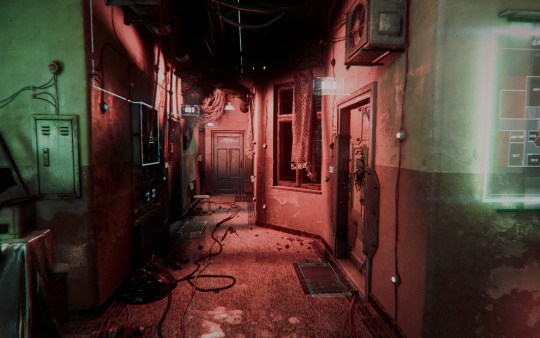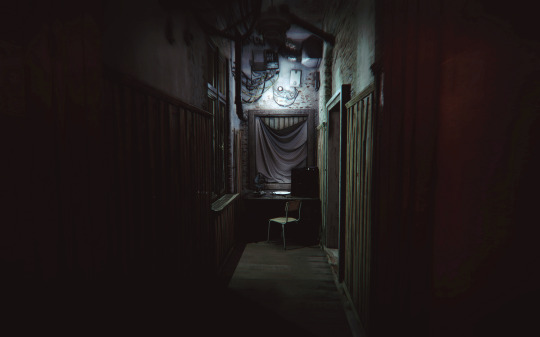#observer system redux
Explore tagged Tumblr posts
Text



my other fictional old man husband
14 notes
·
View notes
Text

#>observer_#observer system redux#cyberpunk games#Bloober Team#game screenshots#virtual photography#eyestrain
58 notes
·
View notes
Text

Loved the original so it was time I got the remaster
2 notes
·
View notes
Text

Hermit's Lair - Human Antithesis https://t.me/Human_Antithesis
Observer: System Redux Original Soundtrack composed by Arkadiusz Reikowski
Observer: System Redux (2020) developed by Bloober Team and Anshar Studios and published by Aspyr
Tracklist:
The Year is 2084 - 01:57
The City View - 01:04
Your Not in Control - 03:10
I Am What They Fear - 01:22
Lockdown - 01:43
Altered Brain - 02:29
The Church - 01:45
Mirror Me - Mother Queen - 07:30
Wolfman - 03:50
Into Your Dreams - 01:59
Whatever It Takes - 04:14
End Titles - 03:59
Mirror Me - Observe Who (Bonus Track) - 05:11
Braindive (Bonus Track) - 01:52
#Hermit's Lair#Human Antithesis#Telegram#Observer#Observer System Redux#OST#Original Soundtrack#Soundtrack#Arkadiusz Reikowski#Poland#Bloober Team
3 notes
·
View notes
Text
So...many...damn...pigeons....
1 note
·
View note
Text





Scenery in Observer: System Redux 02/??
#observeredit#observer system redux scenery#gaming scenery#gamingedit#videogameedit#gifs#observer: system redux#my gifs#flashing gifs#queue
173 notes
·
View notes
Photo

Sometimes I Can’t Sleep #5
5 notes
·
View notes
Text
thought of a brand new sentence (to me) while playing Observer
"Man, I sure wish this apartment building would stop moaning."
2 notes
·
View notes
Text

breaking into your house just to observe you 👁️
🕷️OBSERVER: System redux 🕸️7PM EEST (UTC+3)
3 notes
·
View notes
Text
Humble Cyberpunk Playground delves deep into Steam Play

Humble Cyberpunk Playground Bundle games has support for Proton on Linux via Windows PC. A shout-out to the imaginative team at Humble Bundle. Available as a pay what you want deal while you support charity. Here you are cruising through a future where mega-corporations dictate the rules, and the only light comes from neon signs. That's the captivating universe you'll be immersed in with this incredible collection. And with the Humble Cyberpunk Playground Bundle, you decide how much you want to shell out for it. The first piece of this Humble Cyberpunk Playground Bundle puzzle is ANNO: Mutationem. Coming together in a pixel art style; this isn't your average 8-bit experience. You'll be working through an incredibly detailed city that's brimming with surprises. And there's a supernatural element that'll keep you on sharp. Think of it as a combo of an action-packed blockbuster and a mystery novel, but you're the hero. Next in the Humble Cyberpunk Playground Bundle, we have 'Ghostrunner,' which has received countless accolades and it's easy to see why. Since you're living in a society where every day is a struggle for survival. So the only way to make it is to rely on your lightning-quick reflexes. It's all about fast-paced action that'll where you have to keep moving in this adrenaline-pumping game. Then, Humble Cyberpunk Playground Bundle offers 'Cloudpunk.' Here, you'll step into the shoes of a courier in a massive, cold city where secrets are a currency. It's your job to dig up what lies beneath the surface of this mechanical jungle. It's a unique game, where every turn seems to uncover a new secret.
Humble Cyberpunk Playground Bundle Tiers
$7 USD
Cloudpunk (with Proton)
Voltage High Society (no Proton, but built in Unity 3D)
$10 USD
Ghostrunner (with Proton)
Severed Steel (with Proton)
COUPON 40% OFF Ghostrunner - Project_Hel
$15 USD
ANNO: Mutationem (with Proton)
Observer: System Redux (with Proton)
Gungrave G.O.R.E (with Proton)
These Humble Cyberpunk Playground Bundle adventures are normally valued at $194 USD, but the beauty of this deal is that you call the shots on what you pay. However, the more you decide to contribute, the more you get in return! It's like leveling up in an RPG - except the rewards are these epic games. All these Humble Cyberpunk Playground Bundle experiences can be activated on Steam for Windows. So you can jump right in, get your hands dirty, and immerse yourself in these stunning worlds on Linux, via Proton. Your Humble Cyberpunk Playground Bundle purchase also supports a good cause! The funds go not only to the creators of these adventures but also to 'buildOn,' a charity dedicated to breaking the cycle of poverty. Plus, you can even choose another charity to support. So, you're not just purchasing these exciting story, but also making a real-world difference. And if you've enjoyed the experience, you can even leave a Humble Tip to show your appreciation! That's the whole package. So gear up, set your price as a pay what you want deal, and get ready to lose yourself in the Humble Cyberpunk Playground Bundle neon-lit adventures. Offering Linux players Gold to Platinum support on Linux via Proton.
14 notes
·
View notes
Text

49 notes
·
View notes
Text
Should I make another attempt at playing Observer System Redux?
2 notes
·
View notes
Text
youtube
#Observer#Observer System Redux#Original Soundtrack#Soundtrack#OST#Arkadiusz Reikowski#Poland#Youtube
0 notes
Text


Scenery in Observer: System Redux 04/??
#observeredit#observer system redux scenery#gaming scenery#gamingedit#videogameedit#gifs#observer: system redux#my gifs#flashing gifs#queue
134 notes
·
View notes
Text
Narrative/Database redux
It seems common and at the same time exceedingly difficult to make historical claims about the role of narrative in cultures: not only to to classify the kinds of narratives that circulate within and shape a given culture, but also to establish what constitutes narrative activity itself, to judge its relative importance in that culture’s (self-)understanding against other modes of knowledge, and to furnish an explanation for any changes in its status. Jean-François Lyotard’s Postmodern Condition: A Report on Knowledge (1979) attempts something like this: it registers a “crisis of narratives,” and asserts, in an “extreme” but memorable simplification, that the “postmodern condition” is characterized by an “incredulity toward metanarratives” (xxiv). What Lyotard observes in the post-Marxist, post-structuralist French university is a situation in which “the narrative function is losing its functors, its great hero, its great dangers, its great voyages, its great goal.” The narrative function here is airborne, atmospheric, “dispersed in clouds of narrative language elements—narrative, but also denotative, prescriptive, descriptive, and so on” (xxiv). Patchy language games are figured (and disfigured) as word clouds, as “clouds of sociality,” masses of linguistic particles, whose edges are indistinct and whose commensurability is minimal. For Lyotard, traditional knowledge takes narrative form; the new cloudiness, on the other hand, is the result of a critical confrontation with scientific knowledge, which has always existed in a state of competition and conflict with narrative knowledge. Narrative knowledge is not strictly compatible with scientific knowledge—they are incommensurate language games—and yet the two are necessarily interlinked and in a way interdependent. There is a “return of the narrative in the non-narrative” (27).
Lyotard was already narrating such transformations in knowledge as effects of “information-processing”; he refers to post-WWII modes of bureaucratic and technocratic thinking associated with early processes of digitization: informatics and information theory, systems theory and cybernetics. The burgeoning “computerized societies,” Lyotard writes, are societies through which the “nature of knowledge cannot survive unchanged” (3–4). Lyotard believes that this change will essentially have to do with a crisis of legitimation of narrative knowledge in which narrators and narratees become subjects of vast (and often privately controlled and managed) “data banks” from which it is only ever possible to generate “little narratives” with “local determination” (60).
Around two decades later, once a significant amount of “information-processing” had moved from mainframes to networked personal computers, it became possible to speak of “new media” and “computer culture,” and to evaluate their effects on narrative culture. In The Language of New Media (2002), Lev Manovich makes a distinction that resonates with Lyotard’s: not between narrative and science, but between narrative and database. Manovich, I think, actually relies on Lyotard’s work more than he cites him, providing updates to many of the latter’s key insights. Manovich’s understanding is that narratives and databases may be regarded as “symbolic forms” (following Ervin Panofsky’s history of perspective) that may have more or less prominence in an age, and from the perspective of the late nineties and early aughts, it seemed that databases were supplanting narratives. Databases and narratives are “natural enemies” (225): narratives are stories with beginnings and ends, and with actors who cause, experience, and reflect upon events, while databases, on the other hand, are structured collections of data that can be traversed in a number of ways, only one of which might be narrative (which is “just one method of accessing data among many” [220]).
New media objects like websites, apps, and video games are often databases first, and narratives second (if at all). Using the vocabulary of Saussurean semiology, Manovich claims that they reverse the relationship of syntagm and paradigm. In semiology, the aim was to derive paradigms (or “codes”) which were virtually present in languages, myths, and other syntagmatic utterances (what Saussure called parole). With new media technologies—effects libraries, menus of commands, stock assets, digital games—it is the paradigms which are given, and the syntagmatic dimension which is virtual. “The complete paradigm is present before the user, its elements neatly arranged in a menu” (231). The inscription of paradigms in digital memory can be understood as the technological a priori that conditions much of the transmedia storytelling described by Henry Jenkins, for example, in which world-building and asset management leads, and narrative follows. The convergent logic of the computer, Manovich’s “universal media machine,” becomes the logic of culture at large (236).
Manovich is actually slightly unclear when it comes to the question of medium specificity and media determination—he prefers to think of database/narrative forms outside of any correlation with specific media technologies (“as two competing imaginations, two basic creative impulses, two essential responses to the world” [233]) but a few pages later asserts that the database form is “inherent to new media,” with the digital computer as its “perfect medium” (237, 234). In any case, Manovich gives a number of examples of works in various media—cinema, photography, art—in which the database impulse takes precedence, and in which any temporal succession is detached from a narrating subject or narrative actors, making narrative implicit at most. In the cinema of Peter Greenaway or Dziga Vertov, we are presented with catalogs of events, in which database procedures like sorting and and linking are foregrounded. Greenaway’s work in particular demonstrates quite well how cinematic narrative may be minimally wrapped around around databases ordered by simple algorithms. In Vertical Features Remake (1978), The Falls (1980), The Draughtsman’s Contract (1982), A Zed & Two Noughts (1985), Drowning By Numbers (1988), Prospero’s Books (1991), and other films, narrative persists, but it is subsumed by database operations that exceed it, namely counting and re-sequencing. “Old media” like cinema are particularly adept at registering or transcoding the effects of “new media,” just as “new media” are always incorporating and simulating, to different degrees, features of “old media.”
It is important to think culture algorithmically, as Lyotard had begun to do and as Manovich continues to do, while also being sensitive to the ways in which “pre-digital” objects—and not only Vertov’s cinema and structuralist cultural theory—already made use of databases and algorithms. I find Manovich’s identification of cinema as a database medium to be useful, given outsized influence in twentieth-century media ecology, but I think that the starting point of this media-theoretical narration—as Wolfgang Ernst and other media archaeologists have recognized—can always be moved further and further backward. A wider media-historical scope may provide new perspectives on the fractured, cloudy media landscape of today’s algorithmic culture, which in many ways has surpassed the imaginations of both Lyotard and Manovich.
References
Ernst, Wolfgang. 2013. Digital Memory and the Archive. Minneapolis: University of Minnesota Press. Jenkins, Henry. 2006. Convergence Culture: Where Old and New Media Collide. New York: NYU Press. Lyotard, Jean-François. 1979. The Postmodern Condition: A Report on Knowledge. Minneapolis: University of Minnesota Press. Manovich, Lev. 2001. The Language of New Media. Cambridge, MA: The MIT Press.
4 notes
·
View notes
Text
Fun Fact: this phenomenon is described by an energy load diagram know as the Duck Curve, as observed on the Californian energy grid.

(image credit Energy.gov)
This curve describes power loading on the electrical grid during a high-solar-energy, low-solar-power day (a typical day in California for example). As seen, the load reaches its lowest point at approximately 1-2 PM, which is peek solar hours - at this point certain electrical providers will actually drop their price per kilowatt hour to encourage people to use power less their infrastructure be damaged. then at approximately 5-8 PM the energy consumption MASSIVELY increases - this is when people go home for the day, turn on their AC, stove, and whatnot, just as solar power is waning, causing the large overloading ramp.
This curve tells us a few things:
Prime time to consume power in high-solar areas is at peak solar, avoid consuming power later on if possible (an individual person won't contribute overmuch to this, but the load increase has been proven to come from the residential power sector as a whole).
Practical energy storage solutions must be implemented alongside solar generation else this effect will only get worse and worse - the average Californian grid engineer is a nervous wreak over this since its only a matter of time before the whole grid goes down because of it. Practical methods include pumped hydro (not great in drought areas, but an effective bulk storage method), flywheel storage, and MAYBE batteries (specifically redux-flow batteries - shipping-container sized batteries that may not store a lot of energy, but they are safer more ecologically viable than lithium ion)
Failing energy storage solutions, other forms of power need to be implemented alongside solar - solar is what is known as a non-dispatchable energy source - meaning that its power output can't (generally) be user-adjusted - so however much power it creates is put on the grid (other forms of non-dispatchable power include wind and some wave energy). To "smooth" the duck curve, solar installations could be replaced with either dispatchable power (hydropower, any steam-turbine based reactor, geothermal, etc) or dispatchable power that operates at different peak hours.
A final option is to implement variable loads - mass loads that turn on during solar peak hours and are off at other times. This is less than ideal since it doesn't really solve the issue, just hides it, but it does mean more consistent loading that hopefully the CAISO (California independent system operator) will interpret as greater demand for more redundant lines. Practical uses for this energy include desalinization plants, electrolysis for hydrogen fuel production, or a big siren that blares "California is experiencing technical difficulties, please stand by"
No one in California knows what a Duck looks like, considering this term dates back to 2012, and that grey line ain't look nothing like a duck.

72K notes
·
View notes